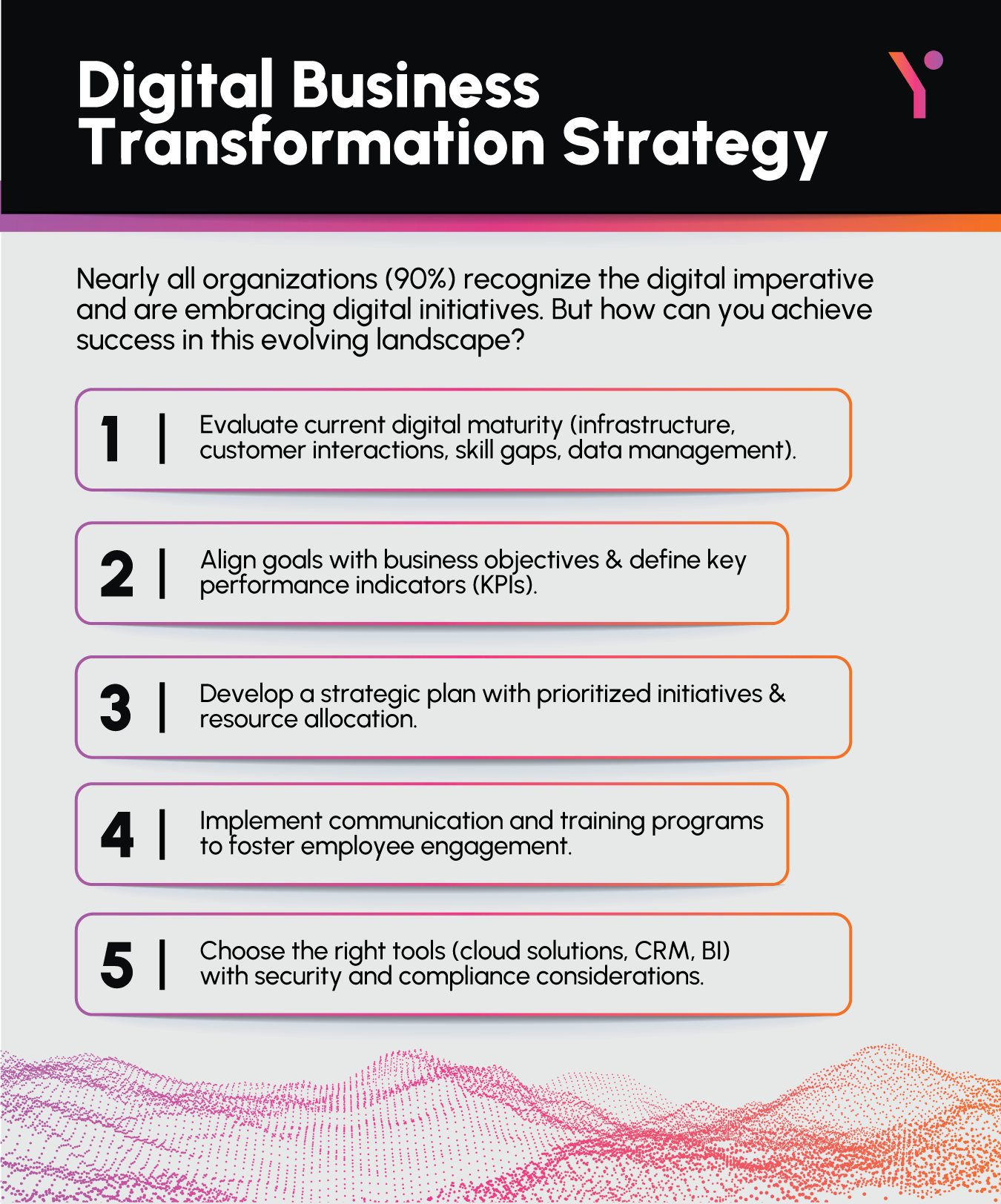Introduction
This blog post is your roadmap! We’ll guide you through the Open Roads digital transformation framework, helping you build a winning strategy, embrace change management, and select the right technology to transform your business.
The business world is a highway in perpetual motion. Stand still without a digital business transformation strategy, and you’ll be left behind by the dust of agile competitors. According to a recent study by Gartner – A whopping 90% of organisations recognise the need for digital transformation and are involved in digital initiatives.
However, navigating the twists and turns of digital transformation can feel daunting if you don’t have the expertise. Fear not! This blog post serves as your roadmap, guiding you through the Open Roads digital transformation framework to craft a winning strategy.
Why Go Digital? The Need to Transform
The business environment is always changing. Today’s customers are digital experts on the move, expecting tailored interactions at all points of contact. Consider a checkout process without any obstacles and suggestions for products that seem to understand your thoughts. Keep up with innovative technologies such as AI and cloud computing and all the latest advancements. Remember, businesses that stick to old methods face the danger of falling behind, encountering stronger rivals and a decreasing portion of the market.
Customer Demands on Overdrive
Customers today crave seamless online experiences. Forget clunky interfaces – they expect personalised recommendations and a checkout process smoother than a drag strip. Traditional brick-and-mortar businesses need a robust digital strategy to keep pace.
Modern Disruptive Technologies
Advancements in technology like cloud computing, artificial intelligence, and automation are changing the way businesses function. Therefore, those who are quick to use these tools to make processes more efficient and increase productivity will have a strong advantage over competitors.
Risks of Stagnation
A break or ignorance on digital transformation can lead you straight off a cliff: We have seen the companies that refuse to embrace digital business transformation challenges risk getting steamrolled by agile competitors who are constantly innovating and adapting to customer needs.
With customer preferences increasingly shifting towards digital experiences, businesses that are still using outdated models may face challenges in retaining their current customer base and appealing to new customers.
How to Set Your Digital Transformation Goals
The successful digital transformation stages begin with a clear end goal, like what you want to achieve with digitalisation.
Align with Business Objectives
Your digital transformation objectives will lead the entire path. Are you looking to expand into new markets and increase your earnings? Perhaps you desire to improve efficiency and reduce expenses. Define your goals clearly to ensure that your digital strategy guides you effectively.
Identify Key Performance Indicators (KPIs)
Identifying key performance indicators (KPIs) is essential after mapping out your goals. These measurements serve as guideposts, enabling you to monitor your advancement and make sure you’re headed in the right direction.
For example, if you aim to enhance customer interaction, your KPIs could involve website visits, mentions on social media, and rates of conversion. Consistently keeping track of these measurements helps you adjust your plan and optimise its effectiveness.
How to Build Your Digital Transformation Roadmap

Now that you have grasped the importance and path of your journey towards digital transformation, it is time to create a plan. This plan will act as your guide, mapping out the necessary actions to reach your digital objectives using the Open Roads framework.
Evaluate Your Current Digital Maturity
Like planning, it is equally important to evaluate your current level of digital maturity. This involves taking a deep dive into four key areas:
Assess Technology Infrastructure
Is your IT infrastructure robust and scalable enough to support digital initiatives? Are there outdated systems hindering performance?
Analyse Customer Touchpoints
How do customers interact with your brand across different channels (website, social media, in-store)? Are these touchpoints optimised for a seamless experience?
Identify Skills Gaps within Your Workforce
Does your workforce possess the necessary skills to navigate the digital world? Are there training needs that require attention?
Moreover, take note of data management – how effectively are you collecting, storing, and analysing data? Is your data secure and accessible to drive insights?
These evaluations will provide a clear picture of your starting point and help you prioritise your transformation efforts.
How Software Solutions Can Help in Digital Business Transformation
Digital transformation often requires leveraging software solutions to address identified gaps and propel your journey forward. Here’s how some key software solutions can empower you:
Cloud Solutions (e.g., AWS, Azure)
Cloud computing provides security and a diverse array of services to aid different digital projects. Cloud solution consultants can assist you through these platforms and help you select the most suitable option for your requirements. For example, transitioning to a cloud-based system can improve your flexibility and ability to grow.
Customer Relationship Management (CRM) Systems
A customer relationship management system consolidates customer information, encouraging better connections and customised interactions. Utilising a CRM system enables you to understand customer behaviours and preferences better, thereby helping you customise your marketing and sales strategies for optimal results.
Business Intelligence (BI) Tools
BI tools turn unprocessed data into useful insights, enabling decisions based on data analysis. These tools can assist you in recognising patterns, monitoring your advancement towards objectives, and enhancing your digital strategy for lasting achievements.
Serverless Applications
Serverless architecture enables the creation and deployment of applications without the need to handle servers. This method decreases both intricacy and expenses, enabling you to concentrate on creativity and essential business operations. Utilising managed Azure services may also assist in assessing the practicality and advantages of developing serverless web applications tailored to your requirements.
By strategically integrating these solutions, you’ll equip your organisation with the digital tools needed to navigate the Open Roads framework and achieve your transformation goals.
Develop a Strategic Action Plan
Once you’ve assessed your digital maturity, it’s time to craft a strategic action plan. This plan will detail the specific initiatives you’ll undertake to achieve your goals.
Prioritise Initiatives
Not all roads are created equal. Identify “quick wins” – smaller, achievable projects that deliver early wins and boost morale. Balance these with long-term projects that lay the groundwork for future success.
Allocate Resources
Building a digital highway requires resources, both financial (budget) and human (personnel). Allocate resources strategically, ensuring your most critical initiatives receive the necessary support.
Factors to Consider When Creating a Digital Business Transformation Strategy
Digital transformation involves more than just advances in technology – it also encompasses human involvement. Therefore, embracing change management is vital. To implement a change, you must efficiently convey the reason for the change and include staff members in the transition. This promotes acceptance and minimises opposition.
Develop Communication Strategies
Stay active with your team by providing consistent updates, town hall meetings, and open communication channels. Transparency fosters trust and guarantees that all comprehend the objectives.
Implement Training and Development Programs
Recognise any deficiencies in skills and offer training programs to prepare your employees with the necessary skills to succeed in the digital era. Upskilling enables workers and nurtures a work environment that values ongoing education.
Select and Integrate the Right Technology
Technology is the powerhouse behind your digital evolution. Nevertheless, the wide range of options present can make choosing the right tools seem overwhelming.
Thoroughly evaluate new tools and platforms based on your particular requirements and objectives. Consider factors like scalability, security, and ease of integration with existing systems.
Ensure Data Security and Compliance
Ensuring the security of data is of utmost importance. Choose options that focus on strong security measures and guarantee adherence to applicable regulations.
By taking these factors into account, you will give your team the ability and provide them with the necessary resources to navigate the digital landscape.
Conclusion
The Open Roads digital transformation framework offers a guide for navigating the intricacies of digital transformation. By assessing where you are now, creating a well-thought-out plan of action, and focusing on both individuals and technology, you can begin your path to reaching your digital objectives effectively.
Keep an eye out for upcoming segments, where we will further examine the framework’s phases and demonstrate how cloud solutions consultants can assist you in creating the necessary digital solutions to succeed in the constantly changing business environment.
Frequently Asked Questions
A Digital Business Transformation strategy provides a plan for utilising technology to enhance business processes, improve customer experiences, and reach your business objectives. Also, the Open Roads digital transformation framework provides a structured approach to navigate this journey.
The Open Roads digital transformation framework delineates multiple stages, each dedicated to certain aspects of your transformation voyage. The steps of digital transformation could involve establishing your digital goals, evaluating your current situation, creating a strategic roadmap, executing solutions, and evaluating progress.
AWS consulting services provide specialised knowledge in AWS cloud computing solutions. These experts can assist you in transitioning your infrastructure to the cloud, creating and launching serverless applications, and using other cloud-based solutions to aid your digital transformation efforts within the Open Roads structure.
The Open Roads framework is flexible and suitable for businesses of any size and in different sectors. This framework can help you navigate your digital transformation journey by emphasising key principles such as assessing your current status, establishing objectives, and executing a strategic plan.
Have questions or feedback?
Get in touch with us and we‘l get back to you and help as soon as we can!




